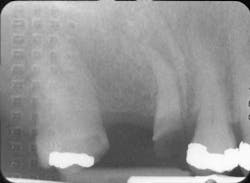Ask the Expert: X-ray answers -- Christopher A. Warren from Carestream Health
Ask the ExpertChristopher A. WarrenTechnical Support EngineerImaging Consultant
Carestream Health, Inc.Exclusive manufacturer of KODAK Dental Systems
Last month we asked you to diagnose the X-ray below and send in your answers on what you think the operator may have done wrong. Today we provide you with the image’s diagnosis!
Stain from incomplete fixation and washing of filmX-ray answersPoor film fixing and washFilms exhibiting a yellow or yellow-brownish color are typically the result of poor processing conditions. The most common cause of this discoloration would be poor chemical quality or exhausted chemistry. In this case, the specific problem in this image would occur because the fixer was diluted or exhausted. The film’s capability to avoid distinct color changes is dependent on the residual ammonium thiosulfate remaining in the film after processing. If the residual thiosulfate is low, a film can turn yellow; however, if the residual thiosulfate is a higher concentration, a film can turn dark yellow to a yellowish brown or maybe even fully brown within a year. So, depending on processing and chemical conditions, this problem can occur immediately or over time. To avoid this problem, I recommend you closely follow the chemical changing and replenishment procedures provided by your processor’s manufacturer. If that’s not handy, as a general rule of thumb I recommend that 8 ounces of replenisher be added to each working solution daily, based on an average daily run of 20 to 30 intraoral films. If you process more than 30 intraoral films per day, you should increase the amount of daily replenisher solution at the rate of 0.25 fluid ounce (7 ml) per additional film processed. Even if no films are processed for a period of time, replenishment is still necessary. It is also important to note that I would never recommend using water in place of replenishment chemicals, because further dilution of chemicals will lead to poor imaging quality.Tips and TricksCreate a daily routineTo maintain the stability and consistency of the processing chemicals, replenish the developer and fixer daily. Regardless of whether or not films are processed, chemicals should be replenished daily to compensate for oxidation.First thing in the morningProcessing solutions should be allowed to reach working temperature before developing images. To remove any residual gelatin or dirt on the rollers, run a piece of Kodak roller transport cleanup film through each side of the processor. Please note that transport films are single-use; reuse can lead to chemical contamination.At the end of the dayRemove the main cover and the developer and fixer covers (unless otherwise stated by the manufacturer) and allow chemical fumes to escape. This prevents condensation droplets from forming under the covers of automatic processors. These droplets soil the rollers, corrode metal parts, and create film artifacts. In manual systems, cover the chemicals to reduce the oxidation processMaintain a logList the date that the processing solutions were changed, the problems that were encountered, and any corrective action taken. Consistent care and preventive action promotes a reliable, predictable, high-quality work environment.Diagnose the X-ray Here is our second in a series of images for you to help identify the problem. Respond correctly and you will have a chance to win a $25 gift card. What did the operator do wrong to achieve this image? Click here to answer. Note: Be sure to include your name, practice, phone number, and e-mail so we can contact the winner of the contest.
Be sure to look for the cause of the problem and Chris’s recommendation in our next issue!Contact usHave a question or concern about your KODAK dental film? If so, contact Chris.Looking for an authorized dealer?Need more information about KODAK dental film, call (800) 933.8031 or visit www.kodakdental.com© Carestream Health, Inc.The KODAK trademark and trade dress are used under license from Kodak.




